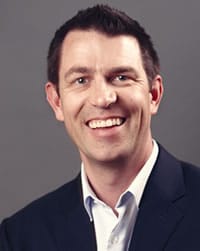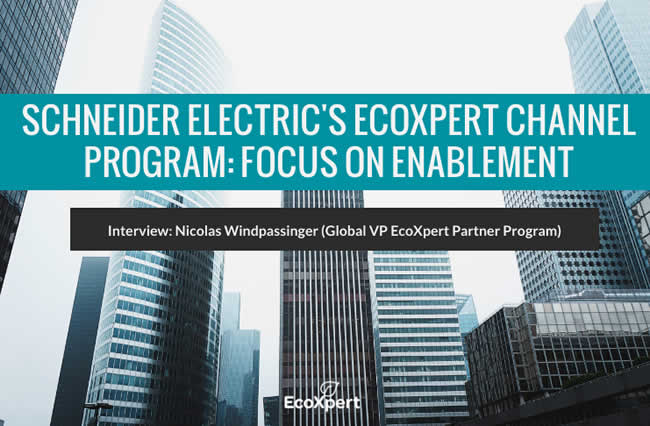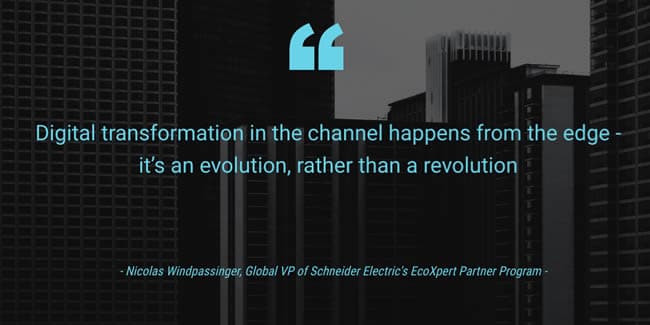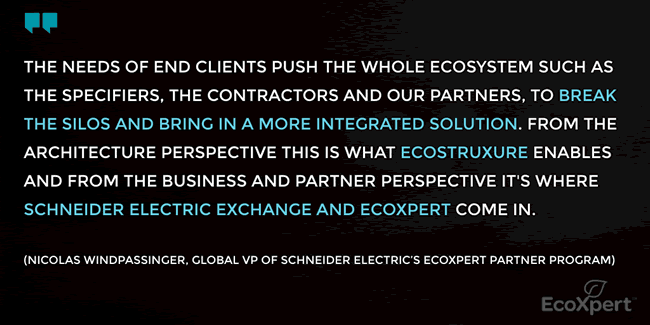Nicolas Windpassinger, IoT expert and Global VP of Schneider Electric’s Partner Program, EcoXpert, on the evolutions in the channel, emerging technologies and changes in the program as end-user needs evolve and new initiatives empower the company’s channel partners to grow, differentiate and be more profitable.

The global EcoXpert channel program of Schneider Electric consists of several certifications and specializations with a network of partners having one or more of these certifications in areas such as building optimization, power management, and energy efficiency.
In April 2017, we conducted an interview with Nicolas Windpassinger on EcoXpert and the IoT channel opportunity. Time for an update and a new interview as the market has evolved quite a bit in over two years, and Schneider Electric hasn’t been sitting still either. Moreover, in 2019 and 2020, EcoXpert again received a 5-Star Rating in CRN’s Partner Program Guide.
Update: also, check out the guest blog Nicolas wrote on digital transformation and the ‘new/next normal’ with advice for EcoXpert channel partners in times of COVID-19.

Consistency with a multi-level local/global approach
While our first interview focused on the potential of IoT (Internet of Things) for various channel partners, we look at how partners are transforming themselves. Digital transformation also takes center stage in an IoT book that Nicolas published in 2017, entitled ‘Digitize or Die.’
Nicolas, first of all, congratulations. EcoXpert continues to be recognized by leading channel publication CRN. You’ve been recognized as one of the most influential channel chiefs in your capacity as global VP of the program again. What do you see as the main reasons for this success?
Nicolas Windpassinger: It’s the sum of the work done on different levels: the countries’ level making sure that the program is successfully deployed and brings value to local partners and markets, the level of various geographical zones, and the global level.
It’s all about making sure we have and continue to have a best-in-class partner program that goes across different areas of expertise and competencies, but that is deployed in a very consistent way across all these geographic zones.
EcoXpert is the only multi-expertise partner program in the industry that goes across different technologies and domains (Nicolas Windpassinger)
How EcoXpert connects with EcoStruxure and Exchange
In 2019, Schneider Electric launched a community of cross-industry experts or, as Cyril Perducat, EVP IoT & Digital Offers, described it “a collaborative workspace, technology resource, and marketplace all at the same time”, called Schneider Electric Exchange. How is this platform related to EcoXpert?
Nicolas Windpassinger: Schneider Electric Exchange is an ecosystem, a business platform where our EcoXperts can showcase their expertise to specifiers, end-users, and their peers, so other EcoXperts.
Secondly, they can develop and have access to all our SDKs and APIs, thereby enriching our offer and their value proposition to the market.
Finally, they can also monetize their expertise, both from a service and a development perspective. If they develop specific capabilities around a particular product, they can monetize those plugins or APIs.
The Schneider Electric Exchange platform is a business enabler for our ecosystem, providing our partners with ample opportunities to grow, differentiate, and be more profitable.
You can see it as part of a three-legged approach. There is EcoStruxure, which is our IoT architecture. Then you have EcoXpert, which is our IoT go-to-market and partner program. And Exchange is our business platform that enables our channel and our products to be accessible, visible, and leverageable for our ecosystem: the three go together.
Digital transformation from the edge in the channel
In our first interview, we mentioned three different types of channel partners with cross-pollination opportunities. These are possible thanks to, among others, the convergence of IT (information technology) and OT (operational technology) – which is the essence of Industry 4.0 and Industrial IoT: the historical IT channel, the historical OT channel, and new types of partners. How has this convergence of IT and OT – from the partner perspective – evolved?
Nicolas Windpassinger: If you look back three or four years ago, about 10% of our partners were multi-badge, meaning that they have certifications and thus expertise and competencies in multiple areas.
Today it’s around 15%, so there is an ongoing evolution whereby partners grow their multi-expertise capabilities to set themselves apart. These partners break the silos between IT and OT’s different technology areas to bring a better solution and better customer experience to the end-users.

The numbers and feedback we get show that this is the direction the channel is taking and that IT and OT are converging, even it’s slowly and gradually. This growth’s gradual character is a widespread market phenomenon: digitalization and the convergence of different technologies take a lot of time. It also requires the necessary time and investments to grow the expertise of our partners.
It’s important to realize that we’re talking about existing partners with specific expertise in a particular field and growing it in another. A typical example would be a BMS partner (Building Management Systems) expanding their capability in areas such as access control, perhaps in wiring and so forth.
From the perspective of technologies such as the IoT technologies we talked about last time, it’s also essential to keep in mind that the market is still getting educated about the possibilities of more connected products and solutions.
That’s why the growth is incremental, and partners make their expertise evolve on their existing core business’s perimeter.
Channel partners continue to acquire more competencies and expertise. They break the silos between different technologies. This takes time and, for us, means investing in growing the expertise of partners. Yet, the evolution in the channel is clear.
This also seems in line with the IoT market overall. The CEO of Belgian IoT company AllThingsTalk mentioned incremental growth too and said it’s important for businesses to start because once they do, they discover new use cases as they go along. Do you recognize this with IIoT as well?
Nicolas Windpassinger: Yes, I agree with that. Partners transform and digitize on the edge (editor’s note: not to be confused with edge computing). And often, that indeed means that they try, discover, and gradually move forward.
In my IoT book, I identified four scenarios describing companies’ approaches with regards to digital transformation whereby transforming from the edge essentially means that companies maintain existing markets and channels while investing money into creating a new opportunity at the edge of their core offerings.
Yet, with transformation from the edge, I mainly focused on manufacturers, and I must say I didn’t expect that transformation from the edge would be happening in the channel: so, it’s an evolution, rather than a revolution as I wrote in the book and it proves to be the same in the channel.
Channel partners try to differentiate themselves and encounter more competition in their core business
Breaking the silos: channel partner and end-user needs in flux
The convergence of IT and OT is one thing. Yet, as explained in a recent interview on harmonics and variable frequency drives, we saw that one of the main reasons this becomes an important topic is the convergence of energy management and industrial automation. How do you think that’s playing out?
Nicolas Windpassinger: We indeed see that partners who are active in industrial automation look more at power management and energy management. Essentially, this also goes back to their efforts to transform from the edge.
They see the opportunity to expand their expertise in other fields and to differentiate themselves in this way. Increasingly, energy management, green energy, and so forth are seen as opportunities by the partners.
The EcoXpert Partner Program consists of various types of partners, yet, in general, what would you say are their main pain points? Is it that need to differentiate themselves, their offerings, and the value they can bring to customers?
Nicolas Windpassinger: Finding ways to differentiate themselves is indeed one of the major pain points. Moreover, they encounter more competition in their core business, pushing them further to try new areas of growth and, again, differentiation.
This is also why you see some of the mentioned dynamics: partners with a strong background in industrial automation trying to move into energy management, building management system partners expanding their scope in other fields, and more IT-oriented partners entering markets like access control.
The risk they have is to stay too much in their core business. The opportunity is to transform from the edge by expanding their expertise, keeping their core application knowledge, and bringing more offers and solutions to the end-users.

You just mentioned end-users. Channel partners, depending on their activities, serve different types of stakeholders, including these end-users, facility owners, construction specifiers, construction clients, anyone in the scope of a building or other construction project. The strategy of channel partners is defined by the demands these have. What are their pain points?
Nicolas Windpassinger: Customer experience plays a vital role for the end clients. Take a hotel, for instance. A key driver for them is to bring back the comfort to their customers and making sure that it’s resulting in a better experience.
The end clients look at their business and what is needed to serve their customers. However, when they then look at the solutions needed to make it happen, they see silos and islands of technologies and solutions they want to connect with one another.
These needs are really pushing the whole ecosystem, such as the specifiers, contractors, and partners, to break those silos and bring in a more integrated solution – and this is where EcoStruxure, Exchange, and EcoXpert come in as well, respectively from the architecture, business, and partner perspective.
The EcoStruxure ecosystem: an ongoing journey, accelerated by an open platform
EcoXpert partners are called the implementation arms of EcoStruxure. You just mentioned why EcoStruxure is essential from the architecture and client demand viewpoint. In a nutshell, can you tell us how it is evolving for people who might be less familiar with it?
Nicolas Windpassinger: EcoStruxure is Schneider Electric’s open, interoperable, and IoT-enabled architecture and platform. It brings in ever more integrated solutions to specific end markets and domains and even more value to those domains and the end-users.
That’s also Schneider Electric’s goal: enabling more connected parts and bringing more value – and this reflects on the channel side as well. EcoStruxure is accelerating with even more APIs, more SDKs, more openness, better integration, etc.
It’s also a journey that started a few years ago and is ongoing, just as the EcoXpert program is a journey, and you can consider Exchange as (part of) a journey of digitizing our ecosystem and enabling it to be more inclusive and more integrated too.
EcoStruxure is a journey that started a few years ago and is ongoing, just as the EcoXpert program is a journey
You mention interoperability and openness. This brings us back to that IoT company interview mentioned before: in their view, many systems are too monolithic, and open systems are essential.
Nicolas Windpassinger: EcoStruxure is designed to be more open, and Schneider Electric Exchange is where the ecosystem can have access to the SDKs or the APIs, develop and then sell the expertise and what they have developed.
So, it’s an accelerator in having more open systems and making sense of this openness for the entire ecosystem. A typical example would be a partner that has developed a specific integration between our BMS system and, let’s say, a room reservation software in a hotel. Usually, they would develop this for a customer in a country. Now they can make it available for all partners across the globe in need of such an integration.
The benefits are clear for everyone: the developer gets access to a broad ecosystem and can do more with the work they did, other partners looking for this type of integration don’t have to develop from scratch, can leverage what exists and in the end, everyone can be more efficient and profitable, regardless of physical location.
This open strategy also reduces the delivery time, which results in end-user satisfaction, profitability, and differentiation of our channel.
The EcoXpert difference for channel partners
Back to EcoXpert. In the beginning, you mentioned the various regional levels and how they work together. Do you also see any significant differences between some regions in terms of, for instance, priorities?
Nicolas Windpassinger: Very often, we think that each country and each geographical zone is unique. Yet, the reality is different: there’s a common trend of more and better-integrated systems and architectures. Overall, there is also a more robust multi-expertise ecosystem and go-to-market of partners.
The differences between countries are related to the maturity of the markets and how they accelerate due to buildings’ existing installed base. Some regions and countries are very dynamic, with many new building projects, and some are less.
I think that’s really what makes the difference between the geographical zones but again: the overall trends are the same – the market’s speed and maturity make the difference.
The expansion of the EcoXpert partner program is the logical consequence of the overall trends that are happening on the offer side and the channel side
In recent years we saw several large companies start with or enhance channel programs as they are crucial to success. Schneider Electric has been very active in the channel for a long time and, as mentioned, is once again awarded. What gives EcoXpert an edge on perhaps some others and differentiates it?
Nicolas Windpassinger: The big difference of EcoXpert is that it’s the only multi-expertise partner program in the industry that goes across different technologies and domains, such as building management, power, light and room control, etc.
It’s also the only partner program deployed in more than 50 countries under one global brand. I believe that this is unique. Moreover, it’s unique in the way we build our IoT-integrated architecture for the channel, and because of the digital platform and capabilities that are now enabled with Schneider Electric Exchange.
Expanding the expertise and competencies of partners with new certifications and specializations
In our previous interview, you mentioned the different certification and specialization areas for EcoXperts, which were subsequently covered in more interviews. You mentioned a few ones such as Light & Room Control, Critical Power, Building Management Systems before. Are there new ones?
Nicolas Windpassinger: Yes, we are expanding the types of expertise and competencies based on our product offers and the need and interest raised by our partners and the end-users.
More recent ones include Substation Automation and Home & Small Business. In the Nordic countries, we are running a pilot in Access Control & Fire. There’s a certification coming around our offering in refrigeration, and we also plan new specialization training programs for existing EcoXperts, among others for retail with several types of retail facilities. There is also a new real estate specialization.
As said before, it’s a journey, and it goes hand in hand with the fact that partners and end clients are trying to look for those more integrated solutions and more expertise under one network of partners. We also expect to add more certifications for panel builders as electrical distribution is changing fast as well.
So, it’s the logical consequence of the overall trends happening on the offer side and the channel side.
Thank you, Nicolas.
Disclosure: i-SCOOP has a commercial collaboration with Schneider Electric. All images are property and courtesy of their respective mentioned owners.

